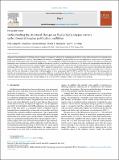Por favor, use este identificador para citar o enlazar a este item:
http://hdl.handle.net/10261/333832COMPARTIR / EXPORTAR:
 SHARE SHARE
 CORE
BASE CORE
BASE
|
|
| Visualizar otros formatos: MARC | Dublin Core | RDF | ORE | MODS | METS | DIDL | DATACITE | |

| Título: | Understanding the structural changes on Fe2O3/Al2O3 oxygen carriers under chemical looping gasification conditions |
Autor: | Samprón, Iván CSIC ORCID; García Labiano, Francisco CSIC ORCID ; Izquierdo Pantoja, María Teresa CSIC ORCID ; Diego Poza, Luis F. de CSIC ORCID | Palabras clave: | CLC CLG Fe-based oxygen carrier |
Fecha de publicación: | 16-ago-2023 | Editor: | Elsevier | Citación: | Fuel 355: 129326 (2024) | Resumen: | Chemical Looping Gasification (CLG) has emerged recently as a promising technology for producing non N2-diluted syngas without the need for an external power supply or the expensive use of pure O2. Many studies have focused on development of oxygen carriers since they are considered a crucial factor in CLG processes. Fe2O3/Al2O3 (FeAl) oxygen carriers have been proposed due to previous experience in Chemical Looping Combustion (CLC). However, the aggressive conditions of gasification cause a decrease in the mechanical stability of the particles, which can be a challenge for their use in CLG. In this work, the operating conditions and Fe-content required to maintain the particle integrity of oxygen carrier particles during redox cycles in both CLC and CLG operations were determined. Long-term tests, consisting of 300 redox cycles, were conducted in a TGA to simulate the operation in a continuous unit and the results were compared with attrition data obtained from a 1.5 kWth CLG unit. Three oxygen carriers with varying Fe2O3-content (10, 20 and 25 wt%) were used, and three different solid conversions (0–25 %, 75–100 % and 0–100 %) were performed to emulate CLC or CLG atmospheres at three temperatures (850 °C, 900 °C and 950 °C). The evolution of the microstructure of particles was analyzed using a scanning electron microscope (SEM) and it was found that the lower the Fe2O3 content in the particles, the greater their stability in redox cycles, an increase in the reaction temperature led to a more rapid degradation of the oxygen carrier particles, and the solid conversion variation and degree of reduction/oxidation during redox cycles strongly influenced the evolution of the mechanical stability of the oxygen carrier particles. | Descripción: | 9 figures, 2 tables. | Versión del editor: | http://dx.doi.org/10.1016/j.fuel.2023.129326 | URI: | http://hdl.handle.net/10261/333832 | DOI: | 10.1016/j.fuel.2023.129326 | ISSN: | 0016-2361 |
| Aparece en las colecciones: | (ICB) Artículos |
Ficheros en este ítem:
| Fichero | Descripción | Tamaño | Formato | |
|---|---|---|---|---|
| 1-s2.0-S0016236123019403-main.pdf | Artículo principal | 8,41 MB | Adobe PDF |  Visualizar/Abrir |
CORE Recommender
SCOPUSTM
Citations
4
checked on 07-may-2024
WEB OF SCIENCETM
Citations
1
checked on 20-feb-2024
Page view(s)
47
checked on 19-may-2024
Download(s)
21
checked on 19-may-2024
Google ScholarTM
Check
Altmetric
Altmetric
Este item está licenciado bajo una Licencia Creative Commons



